Введение
The spur-thighed tortoise, Testudo graeca, Linnaeus, 1758, has a vast area, including North Africa, Southern Europe, South-West Asia and the Caucasus (Ananjeva et al., 2004; Rhodin et al., 2017). It was previously thought that in the Caucasus the subspecies of Т. g. ibera Pallas, 1814 dwells (Bannikov et al., 1977), however then three new subspecies were later described: T.g. armeniaca: Armenia: valley of the Araks river to the Zangezur gate (Chkhikvadze and Bakradze, 1991), T. g. nikolskii: Western part of the Caucasus (Chkhikvadze and Tuniyev, 1986), T. g. pallasi: Dagesten (Chkhikvadze and Bakradze, 2002). According to the latest views, two subspecies are distributed in the Caucasus – T. g. ibera and T. g. armeniaca, from which the last taxon is found in the territory of Dagestan (Rhodin et al., 2017; https://www.reptile-database.org). However, the subspecific structure of the T. graeca is not fully elucidated and remains controversial in many respects (Van der Kuyl et al., 2002; Chkhikvadze, Bakradze, 2002; Korsunenko et al., 2005; Fritz et al., 2007, 2009; Vasilyev et al., 2008; Parham et al., 2012; Mashkaryan et al., 2013; Chkhikvadze et al., 2011, 2014; Rhodin et al., 2017). In recent decades, a decline in the number of T. graeca throughout the area has been observed (Mazanaeva, 2001; Ananjeva et al., 2008; Mazanaeva et al., 2009; Pestov et al., 2009; Chkhikvadze, 2009; Orlova et al., 2011; Mazanaeva, 2013). Until the middle of the last century, it was fairly common throughout the Caucasian part of the area. At the end of the last century, the first information appeared about its decreasing number (Bannikov et al., 1977; Inozemtsev, Pereshkolnik, 1985; Kostina, Galichenko, 1998; Banik et al., 2001; Mazanaeva, 2001; Tuniyev, Tuniyev, 2007; Orlova et al., 2011 and others). It was included in the Red Books of the Russian Federation (2001), Chechen Republic (2007), Krasnodar Territory (2007, 2017), Republic of Dagestan (2009), Azerbaijan (2013), Georgia (1982) and Armenia (2010), as species with a steadily declining number and inhabitance area, individual populations of which are on the verge of extinction. In the IUCN Red List-2018, it is assigned the status of a vulnerable species (category VU) (https://www.iucnredlist.org).
T. graeca populations in Dagestan inhabit the northern periphery of the whole species’ area. The northern boundary of the regional area runs along the Narat-Tyube Mountain Ridge 22 km east of the Sulak River (43º05´20.83 N, 47º05´00.46 E). Further, the ridge stretches South-East along the Primorskaya (terraced) lowland and the adjacent foothills (up to 700 meters above sea level) to the border with Azerbaijan (Mazanaeva, 2001; Mazanaeva et al., 2009; Mazanaeva, 2013; Mazanaeva, Gichikhanova, 2018). In the first half of the last century, the tortoise lived in various biotopes, its population was quite numerous – in places of accumulation about 100 individuals per 1 kilometer route, which is about 10 individuals per ha (Krasovsky, 1932; Bannikov, 1951). In the second half of the 20th century, the first information appeared about a sharp decrease in the number of tortoises in the South-Eastern part of the area: its number in some biotopes was 1 individual per ha. At the same time, in the most optimal biotopes in places of accumulation, the density was estimated as 10 individuals per ha (Bannikov et al., 1977; Kostina, Galichenko, 1998; Dzhamirzoev, Tertyshnikov, 2000; Banik et al., 2001; Mazanaeva, 2001). The reduction in the number of tortoises was a consequence of the active migration of the population in the 1960–70s from the mountainous regions to the Primorskaya (terraced) lowland and the adjacent foothills, which resulted from the economic development of a large area of tortoise habitats. By the beginning of the 21st century, there had been a decrease in its numbers and a fragmentation of the area, lowland and foothill populations were isolated by anthropogenically transformed landscapes of various size, in some places – by several tens of kilometers (Mazanaeva, 2001; Mazanaeva et al., 2009; Mazanaeva, 2013). In recent decades, recreational and economic development of preserved natural landscapes where tortoises live has intensified, and therefore the tendency of decrease in its number and area fragmentation has continued (Mazanaeva, Gichikhanova, 2018; and others). The purpose of our work was to assess the current state of T. graeca populations in Dagestan and to give recommendations for developing a strategy for the conservation of this species in the region. We had the following tasks: to study the current distribution of T. graeca in Dagestan, to determine the main limiting factors, to determine the degree of area fragmentation, to determine viable populations and the area of habitats they occupy, to determine the approximate (relative) density of the tortoises in them, and to create protected areas.
Аналитический обзор
Characteristics of the research area. The Republic of Dagestan is located in the north-eastern part of the Great Caucasus Mountain Ridge and in the South-Western Caspian lowland within 42°12' North latitude, 45°08' and 47°35' East longitude. In the North along the Kuma River it borders with Kalmykia, in the North-West – with the Stavropol region, in the West – with the Chechen Republic, in the South along the crest of the Main Range it borders with Georgia and Azerbaijan, with the latter the border continues along the Samur River to the Caspian Sea. The area of the republic is about 50300 square kilometers. According to the nature of the terrain, the territory of the republic can be divided into four physiographic regions: lowland, foothill, intramountain and alpine (Guyl et al., 1959; Gurlev, 1972, etc.).
The lowland of Dagestan is an extreme southwestern continuation of the Caspian lowland. It occupies a little less than half of the territory (about 42 %) of Republic. Its surface is represented by a flat, slightly sloping plain with alluvial-accumulative relief. Most of the lowland is below sea level. Within the borders of Dagestan, it is represented by the Tersko-Kumskaya lowland, the Tersko-Sulakskaya lowland and the Primorskaya lowland.
The Primorskaya (terraced) lowland is an elongated narrow coastal strip between the Caspian Sea and foothills, which stretches from the city of Makhachkala to the border with Azerbaijan. Its length is about 160 kilometers, its width does not exceed 10–25 kilometers anywhere, and in three places (near the city of Izberbash, the village of Kayakent and the city of Derbent) the spurs of the mountains closely approach the sea. Its height distribution ranges from –28 (to level of the Caspian Sea) to 150–200 meters at the foot of the mountains. The relief of the lowlands is characterized by the presence of ancient Caspian terraces, the ledges of which are interrupted by river valleys. The seashore is a narrow (100–500 meters) strip of the beach, covered with sand and shattered shells, forming almost all low (from 2 to 10 meters) ramparts and dunes. The natural dry-steppe and semi-desert landscapes occupy the first and second marine terraces, remaining only on areas of the lowland that are absolutely unsuitable for agricultural development. Within its areas there are landscapes that are not characteristic of this zone, they are floodplain forests along rivers flowing into the Caspian Sea. The climate is arid with relatively warm winter (average January temperature +1 °C), hot summer (average July temperature +28 °C) and the highest annual average temperature for Dagestan (+12.6 °C). The average annual rainfall is about 200 millimeters. Higher terraces represent cereal-wormwood dry steppe with freegan-type areas, the seaside strip is covered with wormwood-saltwort and saltwort, and in the lowlands there are meadow and meadow-forest combinationsand flood-irrigated-type forests (oak, willow, poplar, etc.) (Schiffers, 1946; Chilikina, Schiffers, 1962; Gurlev, 1972; Eldarov, 1972; Ataev, 2002).
The foothills occupy the lower stages of the outer macro-slope of the forward ranges, stretching from the Northwest to the Southeast along the periphery of mountainous Dagestan in the form of a continuous chain interconnecting with the arrays of the Lateral Ridge. At altitudes from 150–200 to 500–600 meters above sea level, arid landscapes are widespread (clay semi-deserts, dry foothill steppes, slips), and at 600–1200 meters above sea level – the piedmont forests. Mountainous xerophytes are common in steppe and forest landscapes; they occupy large areas in the most arid parts. The foothills are heavily dissected by the longitudinal and transverse valleys of the rivers flowing towards the Caspian Sea. The southeastern foothills between the Ulluchai River and Karchagsu River (tributaries of the Rubas River) have a dissected landscape, represented by small hills (200–350 meters above sea level) consisting of sandy-clayey Akchagyl (Paleogene) easily washable sediments. The climate of the foothills is usually moderately warm, with relatively mild winters and rather hot summers. The annual precipitation is 300–400 mm, the average air temperature in July is + 19.7–21.8 °C, in January - 0.8–1.0 °C (Schiffers, 1946; Guil, 1959; Chilikina, Schiffers, 1962; Gurlev 1972; Eldarov, 1972).
Material. The studies were conducted in 2013–2019 in the Primorskaya (terraced) lowland and in the foothills of Dagestan. All the habitats of the T. graeca known from literary data were studied from the spurs of the Narat-Tyube Ridge to the border with Azerbaijan. The territory with a total area of about 418100 ha was surveyed. During the study period, we had accounted 500–600 mature individuals of spur-thighed tortoise.
Methods. The study of distribution and biotopes was carried out according to generally accepted methods (Shlyakhtin, Golikova, 1986; Shcherbak, 1989; Heyer et al., 2003). In describing biotopes we used a geobotanical description of landscapes (Grossheim, 1949; Chilikina, Schiffers, 1962; Gulisashvili et al., 1975; Galushko, 1978; Murtazaliyev, 2009). We calculated the approximate area using the QGIS2.18 program. Counting the number of tortoises was carried out according to generally accepted methods. The length of the transect was 2000 meters, the width in semi-desert and dry-steppe landscapes was 200 meters, on the slopes with arid shrub vegetation and delta forests – 100 meters. The number of individuals in habitats with dissected relief was counted at sites measuring 50 х 50 meters (Novikov, 1949; Dinesman, Kaletskaya, 1952; Darevsky, 1987; Scherbak, 1989; Heyer et al., 2003). To exclude repetitions, tagging of individuals was carried out by marking the pleural shields of the carapace in a specific sequence: the right pleural shields were numbered as ones, and the left ones were marked as tens (the method used by M. V. Pestov and passed to us in oral communication). The counts were carried out in the period of the greatest activity of the tortoises: in spring and early summer. Only mature individuals were taken into account due to the secretive way of life of immature and juvenile individuals. We conducted a survey of the population of villages and towns for the presence of land tortoises.
Results. For a convenient and consistent presentation of the obtained data, we conventionally divided the known area of distribution of T. graeca in the republic into three parts: South-East, Central and North-West.
The South-Eastern part of the area included the lower foothills, the coast of the Caspian Sea and the Samur River delta. Its area in the middle of the 20th century was 173600 ha, at the beginning of 21st century it was 129200 ha. The tortoise inhabited various biotopes: a sandy steppe covered with bushes at the base of coastal dunes, tugai thickets of coastal lowlands, clayey and stony semi-deserts with wormwood-grass and forb-grass vegetation, dry foothill steppes, arid light forests and thickets of xerophytic shrubs on the mountain slopes, areas of floodplain and delta forests, agricultural landscapes at altitudes from -20 to 500 meters above sea level (Krasovsky, 1932; Bannikov, 1951; Bannikov et al, 1977; Kostina, Galichenko, 1998; Mazanaeva, 2001; Mazanaeva et al., 2009). During the study period, tortoise populations were found within the foothills between the Gyul'gerichay River and Samur River, as well as between the Gyulʹgerichay River and Karchagsu River. To the North the tortoise inhabits the area named "Shurdere" (Fig. 1a), which is located between the Gyulʹgerichay River and Rubas River. Another tortoise population lives on the slopes of the Sabnovo-Dzhalgansky ridge (near the city of Derbent). In these areas T. graeca inhabits clayey and stony semi-deserts with rare bushes of Paliurus spina-christi, Сerasus incana, Tamarix ramosissima (in the spring ephemerae and ephemeroids of Роа bulbosa, Helianthemumsa licifolium, Filago arvensis, sp. Bromus, Aegilops, Medicago, Trifolium, Alyssum, Xeranthemum develop) (Fig. 1b), dry steppes (grassy wormwood and motley grass with Teucrium sp., Eryngium, Salvia, Inula, Dianthus, Festuca, Artemisia, Andropogon, Stipa), mountain slopes sprouted with xerophytic shrubs (Rhamnus, Spiraea, Spiraea, Eriobotrya) and rare oak woodlands (Quércus sp., Cárpinus, Crataegus, Acer, Fráxinus) (Fig. 1d). The average tortoise density in these biotopes is 0.18 individuals per ha. On a lowland in the delta of the Samur River (on the Southern boundary of the regional area), T. graeca inhabits coastal semi-desert-steppe landscapes (Fig. 1c), as well as the outskirts and edges of the Samur forest. The average tortoise density in these habitats is 0.7 individuals per ha. This population and the foothill populations are isolated by the federal highway "Caucasus" and the associated agglomeration. In the biotopes of the South-Eastern part of the area T. graeca coexists with Zamenis hohenackeri, Lacerta strigata, Pseudopus apodus, Paralaudakia caucasia, Eremias velox, Dolichophis schmidti, Eirenis collaris, Typhlops vermicularis, Ophisops elegans, Eumeces schneideri, Macrovipera lebetina, Platyceps najadum, Telescopus fallax, Vipera ursinii, Natrix natrix, N. tessellata, Mauremys caspica, Emys orbicularis and others. We did not find the spur-thighed tortoise in the previously known habitats on the Caspian Sea coast between the mouths of the Rubas River and the Uluchay River, as well as in the foothills in the adjacent territories of the Derbent, Kaitag and Kayakent Districts. According to our data, the area of destroyed habitats is about 37540 ha. The main factors of changing the areas and the decrease in the tortoise number are the recreational use of the sea coast, the expansion of cities and towns, economic activity (development of the agricultural sector and overgrazing of livestock). However, the main factor leading to the reduction of the area of natural biotopes, and, accordingly, the number of this species, is the intensive removal of sand from the coast over the past two decades. The impact of all these factors continues at the present time. Building and fencing of sites of the Samur forest located outside the Samur Federal Reserve and the entire coast is also ongoing. The active agrarian (economic) development of the foothills remains.
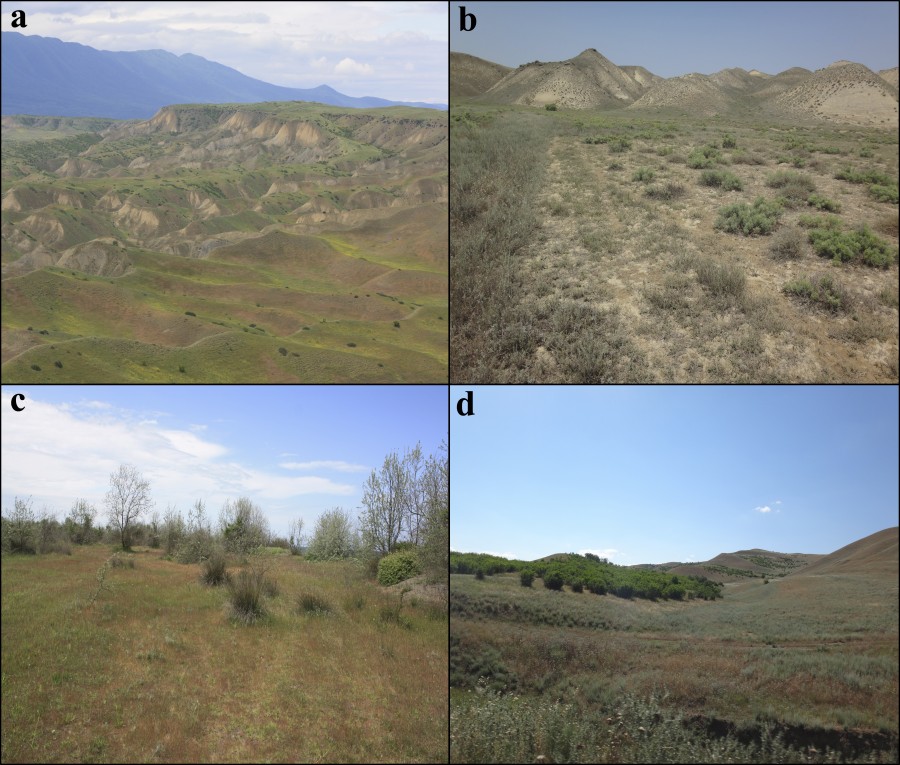
Fig. 1. Habitat of T. graeca in the south-eastern part of the area: a) foothill dry steppes in the Shurdere locality; b) foothill of the steppe semi-deserts in the vicinity of Gelinbotan; c) foothill of wormwood-grass steppe and oak woodlands in the vicinity of Gedzhuh; d) coastal semi-desert steppes in the Samur delta
The central part of the spur-thighed tortoise area includes the foothills and the Caspian Sea coast between the Ulluchay River and the Dzhangakaluchai River. This area in the middle of the 20th century was 119600 ha, at the beginning of 21st century it was already 57700 ha. The tortoise widely inhabits the fixed sands along the Caspian Sea coast, semi-desert and steppe lowland phytocenoses, floodplain forest massifs, dry foothill steppes, xerophytic thickets on the mountain slopes at heights from -18 to 550 meters above sea level, as well as household plots, vineyards and vegetable gardens (Bannikov, 1951; Mazanaeva, 2001; Dzhamirzoev, Tertyshnikov, 2000; Bannik et al., 2001; Mazanaeva, 2001; Mazanaeva et al., 2009; Mazanaeva, 2013). The densities of T. graeca in places of accumulation were 8–11 individuals per ha (Bannikov, 1951; Bannikov et al., 1977). We found only two populations in this part of the area: in the foothills between the Bashlychay River and the Gamriozenʹ River (near the village of Shalasi) and on the coast of the Caspian Sea in the vicinity of the lagoon of Adji Lake (Papas). The population of the foothills inhabits the slopes of mountains with wormwood-grass steppes, and along the slopes of the Northern and North-Western exposure it inhabits mixed grass steppes with thickets of xerophytic bushes (sp. Kochia, Сарparis, Paliurus, Rhamnus, Spiraea, Pyrus). The average density of this population is 0.3 individuals per ha and the area of the remaining habitats is 6700 ha. In the vicinity of Adji Lake (Papas), the tortoise lives on coastal dunes (Fig. 2) and on fixed sands at their base (sp. Pyrus, Rubus, Rhamnus), as well as on semi-desert areas with wormwood-cereal (Fig. 3), their length is about 7 kilometers extending from the North to the South.
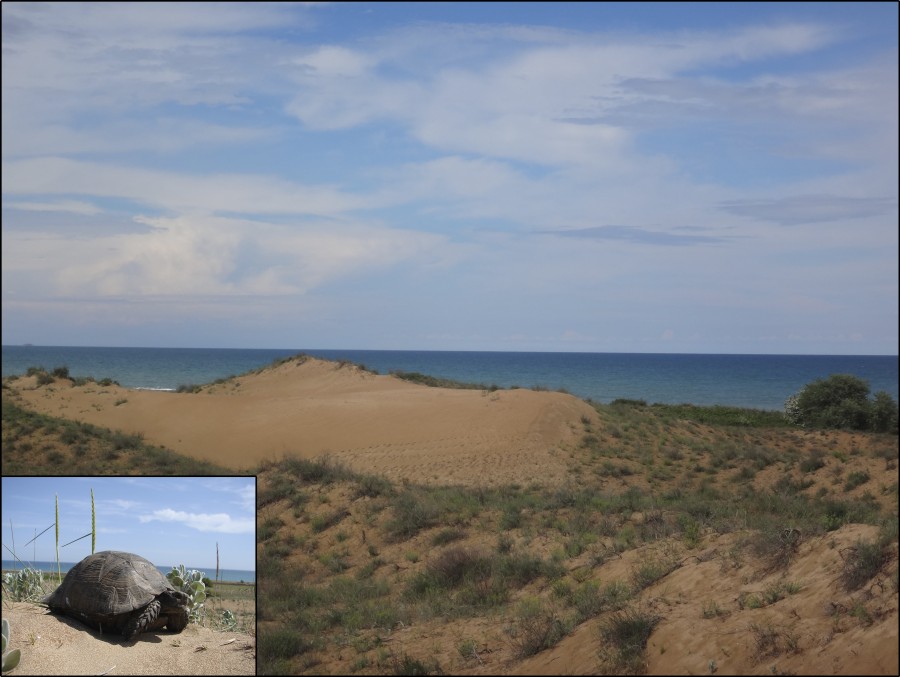
Fig. 2. Habitat of T. graeca in the central part of the range on the coastal dunes of the Caspian Sea
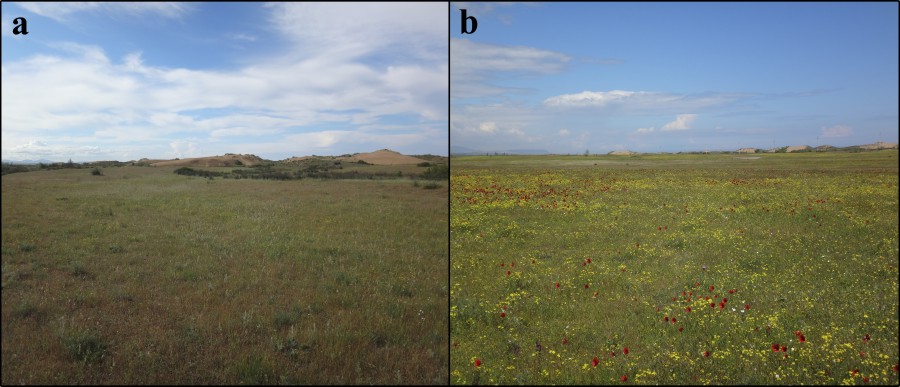
Fig. 3. Habitat of T. graeca in the central part of the area between Lake Adji (Papas) and the Caspian Sea: a) sandy wormwood-grass steppe; b) sandy mixed grass and cereal steppe
The average density of the tortoise is 1 individual per ha, with the area of the remaining habitats being 1300 ha. These populations are isolated from each other by the federal highway "Caucasus" and its associated agglomeration, as well as by extensive anthropogenically transformed landscapes. In this part of the area T. graeca coexists with Pelobates syriacus, Lacerta strigata, Pseudopus apodus, Eremias arguta, Eremias velox, Dolichophis schmidti, Elaphe sauromates, Eryx jaculus, Platyceps najadum, Macrovipera lebetina, Natrix natrix, N. tessellata, Mauremys caspica, Emys orbicularis. We did not find a turtle in previously known habitats on the Caspian Sea coast between the Gamriozenʹ River and the Izberbash city, as well as on the foothills between the Incheozenʹ River and the Dzhangakaluchai River. According to our data, the area of destroyed and degraded biotopes is about 111600 ha. The main factors of it are the recreational pressure on the Caspian Sea coast, the expansion of cities and towns, as well as the work of numerous sand and stone quarries, the development of the agricultural sector and overgrazing (Fig. 4, 5).
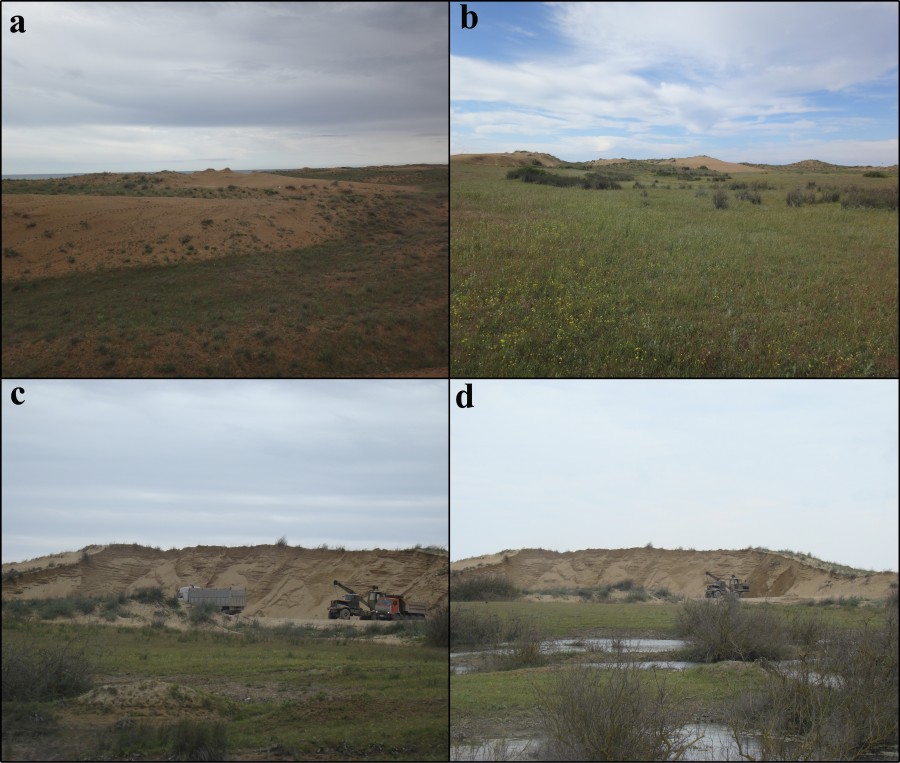
Fig. 4. Habitats of T. graeca in the central part of the area between Lake Adji (Papas) and the Caspian Sea in 2014 (a, b) and their state in 2019 due to sand removal (c, d)
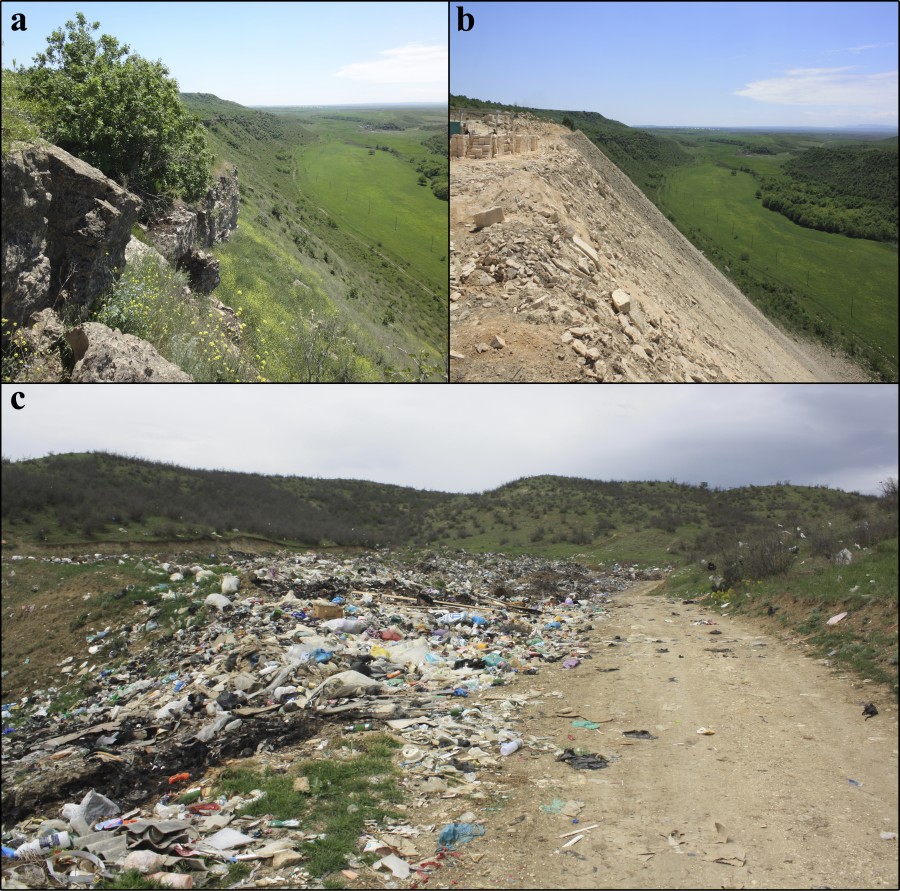
Fig. 5. Habitat of T. graeca in the central part of the area on the slopes of the Kanaburu Ridge in 2016 (a) and the state of these biotopes in 2019 due to the stone quarry (b); littering of habitats in the central part of the range in the foothills (near the village of Murego) (c)
The north-western part of the area included foothills from Cape Buinak near the Izberbash city (the Kanaburu and the Narat-Tyube Ranges) to the environs of the Sarykum Barkhan and the coast of the Caspian Sea between the Dzhangakaluchai River and the Southern edge of the Kaspiysk city. The area of the range in the middle of the 20th century was 124900 ha, and at the beginning of the 21st century it is 71600 ha. The tortoise inhabited the various habitats: sandy semi-desert, riparian thickets along the coast of the Caspian Sea, arid clay steppes of ancient Caspian terraces, river valleys, mountain slopes with xerophytic bushes and with oak woodlands, or pine, or juniper woodlands at altitudes from -20 to 600 meters regarding sea level (Bannikov, 1951; Bannikov et al., 1977; Leontyeva et al., 1998; Mazanaeva, 2001). We have marked the tortoise populations during our research of the foothills on the Eastern macroslope and Western macroslope of the Kanaburu Ridge, on the slopes of Mount Kukurtbash and on the north-eastern macroslope of the Narat-Tyube Ridge. According to our data, at present, within this part of the area, the tortoise is sporadically distributed, inhabiting various biotopes of the foothills. In this area, the tortoise inhabits the sandy steppes covered with bushes at the foot of the dune Sarykum, as well as dry foothill steppes (with Koeleria, Poa, Festuca, Centaurea, Dictamnus, Sedum, Glycyrrhiza, Asplenium, Stipa, Andropógon), river valleys, on mountain slopes with xerophytic shrubs (Cotinus, Euonymus, Cerasus, Spiraea, Juniperus, Rhamnus, Lonicera, Celtis, Ephedra, Rosa, Ligustrum, Lonicera, Cotoneaster), pine woodland and oak woodland (Pinus, Juniperus, Quercus, Populus, Cotinus, Cotoneaster, Sorbus), and juniper woodlands (Kochia, Сарparis, Paliurus, Acer, Cornus, Pyrus, Berberis, Rosa, Lonicera, Cotinus) (Fig. 6).
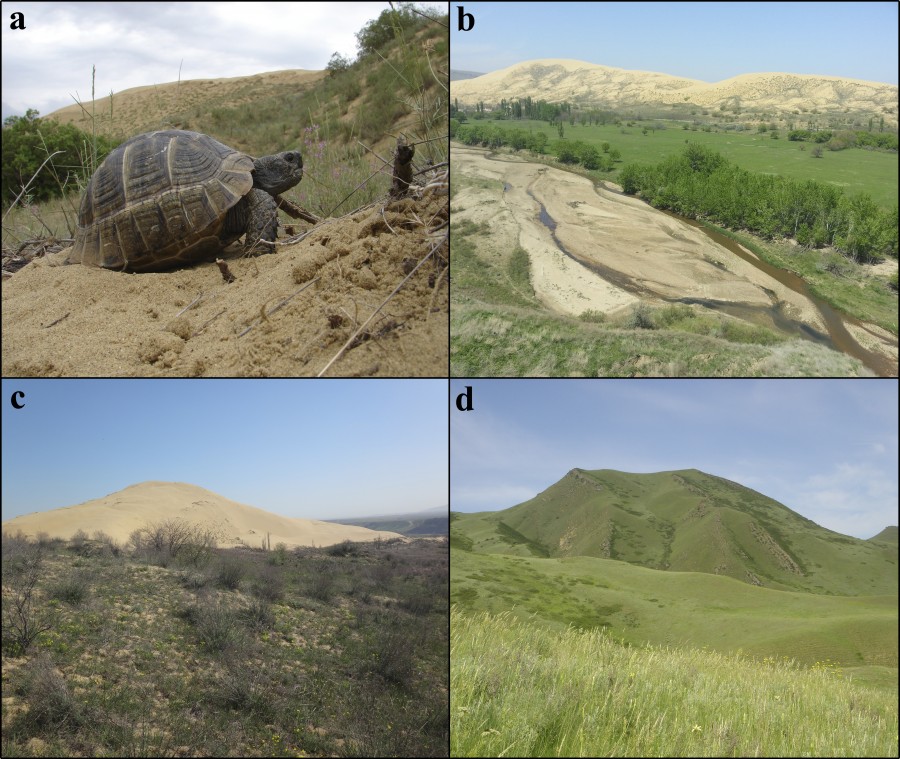
Fig. 6. Habitat of T. graeca in the north-western part of the range: a) on the mainland dune (Sarykum Dunes section of the Dagestan reserve); b) in the valley of the Shuraozenʹ River; c) in the sandy steppe at the base of the continental dune (the Sarykum Dunes section of the Dagestan reserve); d) on the slopes of the Narat-Tube Ridge to the West of the city of Makhachkala – dry steppes with thickets of arid shrubs
The average tortoise density in these habitats is 0.17 individuals per ha. In this part of the area T. graeca coexists with P. apodus, Paralaudakia caucasia, L. strigata, E. arguta, E. velox, N. natrix, N. tessellata, Eirenis collaris, Typhlops vermicularis, Telescopus fallax, Hemorrhois ravergieri, M. lebetina, D. caspius, E. jaculus, P. najadum, E. orbicularis, M. caspica. We did not find T. graeca in previously known habitats on the Caspian Sea coast between the mouth of the Kolichi River and the Southern edge of the city of Kaspiysk (Fig. 8, 9, 10). According to our data, the area of degraded and destroyed habitats in the north-western part of the area is 87900 ha. The main factors are the recreational load on the coast, the expansion of cities and towns, the work of numerous sand pits, especially on the coast and stone pits in the foothills, as well as the development of the agricultural sector and overgrazing (Fig. 7, 8, 9).

Fig. 7. Destruction of habitats of T. graeca in the north-western part of the range – the consequences of the operation of the quarry for the extraction of gravel and rubble (near the village of Karabudakhkent)
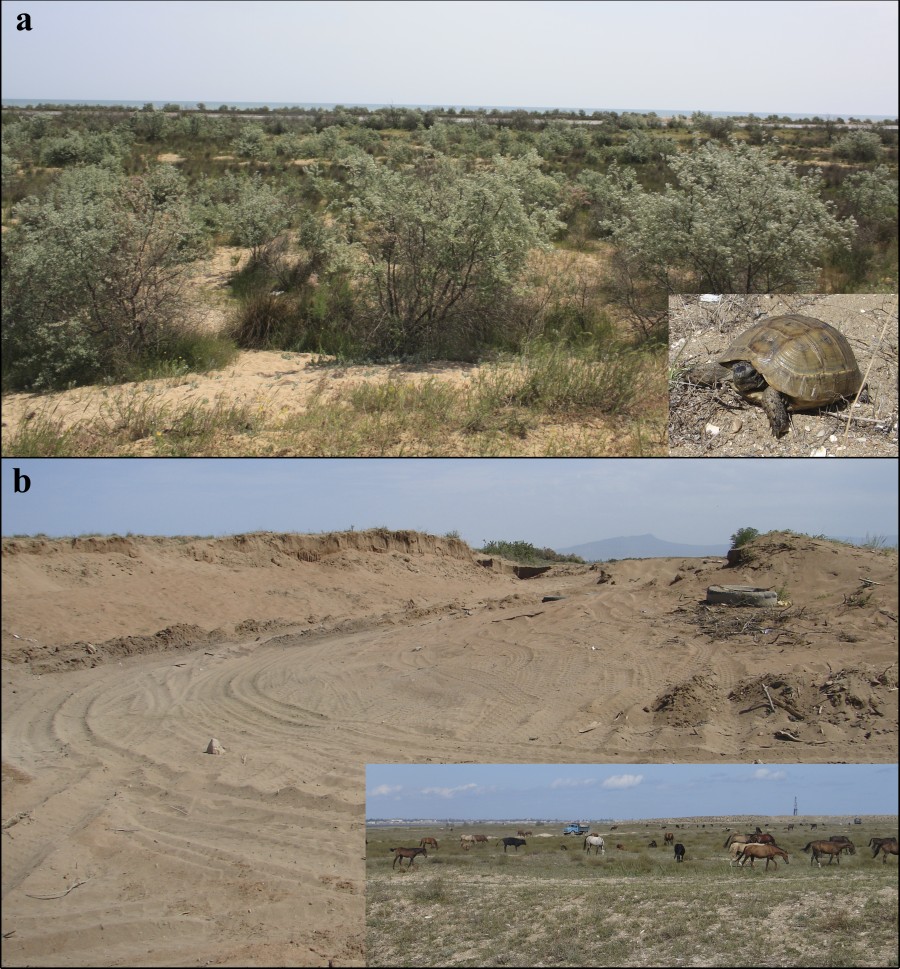
Fig. 8. Habitats of T. graeca in the north-western part of the ridge on the southern outskirts of the city of Kaspiysk between the Caspian Sea and lakes Big and Small Turali in 2014 (a) and the state of these biotopes in 2019 due to sand mining (b)
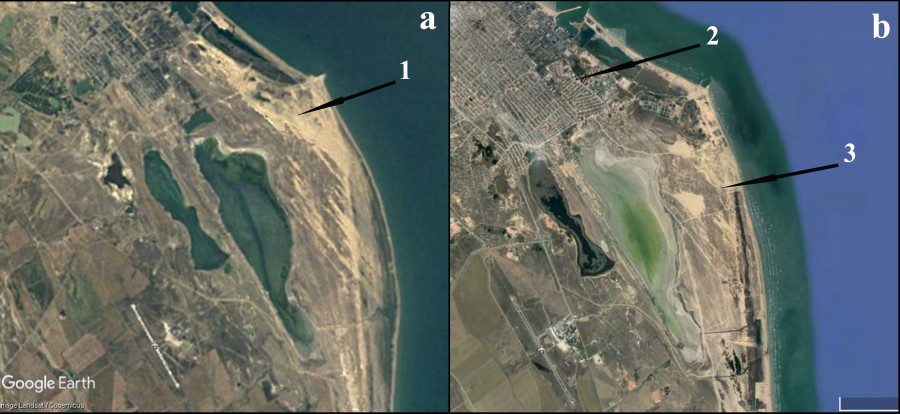
Fig. 9. Comparison of the habitat status of T. graeca in the north-western part of the area on the southern edge of the city of Kaspiysk between the Caspian Sea and lakes Big and Small Turali according to Google Earth Pro: a) in 1970; b) in 2018; 1 – coastal dunes, 2 – pits remained after sand removal, 3 – coastal buildings
Заключение
The total area of the range of T. graeca in the middle of the 20th century was 418100 ha, at the beginning of the 21st century it is already 258500 ha. According to our data, the total area of habitats of this species currently left is about 106600 ha; by the beginning of the 21st century the regional area has decreased 1.6 times (about 62 % of the total area), and to date it declined by more than 3.9 times (about 74 % of the total area). These data indicate a progressive reduction of habitats and the number of the spur-thighed tortoise in Dagestan. The average number of tortoises on the coast of the Caspian Sea according to literary data in the middle of the 20th century was 8–11 individuals per ha, at the beginning of the 21st century it was 1.5 individuals per ha (Krasovsky, 1932; Bannikov, 1951), according to our data, currently the number of tortoises is 1 individual per ha. In the foothills, the average number at the beginning of the 21st century was about 0.33 individuals per ha (Mazanaeva, 2001), according to our data, the average number is currently about 0.21 individuals per ha. According to our expert assessment, at present, the total number of mature spur-thighed tortoises in Dagestan is about 700 individuals. Such a sharp reduction in the tortoise number by the beginning of the 21st century had been due to the increasing influence of different anthropogenic factors. In the 1960s–1970s, the people population resettles from mountainous areas to the foothills and lowlands. This led to the expansion of existing cities and towns, as well as the emergence of new villages and towns. As a result, the active recreational development of the coastal plain of the Caspian Sea began, the development of agriculture (the areas of agrophytocenoses increased significantly), and numerous quarries for the extraction of sand and stone arose. At the beginning of the 21st century, the main anthropogenic factor contributing to a significant reduction in the tortoise number is the destruction of its natural habitats, as a result of the work of numerous quarries for the extraction of sand, soil, gravel and stone on an industrial scale. Sand was extracted most extensively on the south-eastern coast of the Caspian Sea, where the most optimal biotopes were inhabited by viable populations of spur-thighed tortoise. Along with sand, the clutches, juveniles and often adult individuals were withdrawn. Many individuals died under the wheels of heavy cars with sand. The expansion of the agglomeration along the federal highway "Caucasus" led to the isolation of foothill and lowland tortoise populations. The work of numerous stone quarries contributed to the destruction of habitats in the foothills. All this led to a significant reduction in the habitat areas of T. graeca on the coast of the Caspian Sea and to the fragmentation of its area in the foothills. According to our data, at present, two small isolated areas of its habitat stay within the south-eastern coast: the first is located in the delta of the Samur River, the second is located in the vicinity of the largest lagoon of Adji Lake (Papas). Three relatively isolated habitat areas remained in the foothills – the area "Shurdere", in the Kayakent District South-East of the village of Shalasi, and on the slopes of the Narat-Tyube Ridge (Fig. 10).
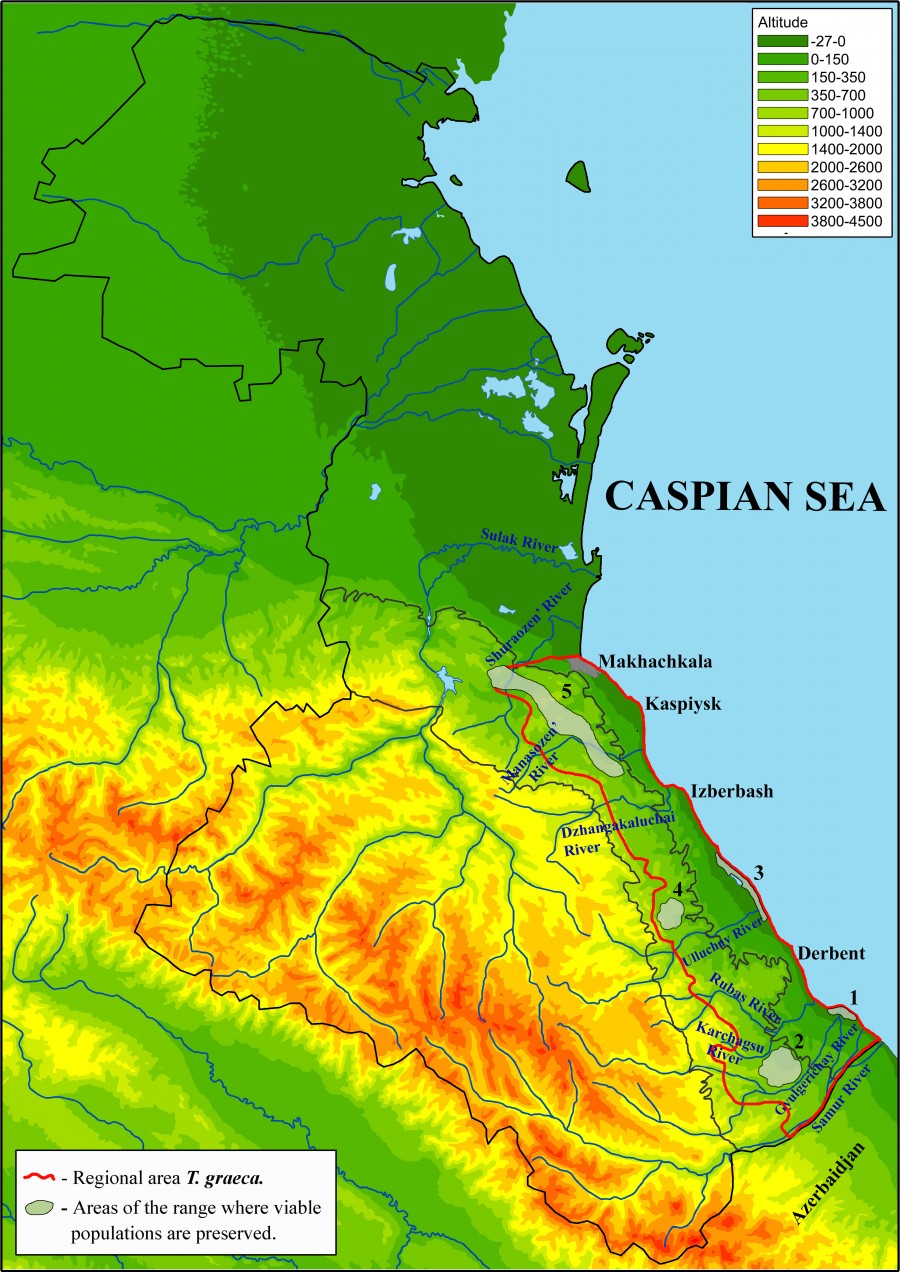
Fig. 10. Habitat of T. graeca in Dagestan in 2001 (according to Bannikov et al., 1977 with modifications and Mazanaeva, 2001) and the main surviving habitats in 2019: 1 – habitat in the Samur delta; 2 – habitats in the Shurdere locality, 3 – habitats in the vicinity of Adji Lake (Papas); 4 – habitats in the vicinity of the village of Shalasi, 5 – habitats on the slopes of the Narat-Tube Ridge
Currently, in order to preserve these tortoise populations, it is necessary to ensure their effective territorial protection. The existing network of specially protected natural territories in the republic cannot contribute to the conservation of this species in the region. According to our data, the habitats of T. graeca are represented only in two Federal subordinate specially protected natural territories – in the Samursky and in the Dagestansky (Sarykum dunes) reserves. However, due to the small area of the tortoise' biotopes in them, they do not contribute significantly to the preservation of viable populations. To preserve this species in Dagestan, it is necessary to organize new protected areas and expand the boundaries of existing Federal subordinate protected areas. We believe that the preservation of the tortoise population in the south-eastern part of the area will contribute to the expansion of the borders of the Samursky reserve by incorporating the remaining habitats in the coastal semi-desert landscapes. It is also necessary to include the foothill area Shurdere with an area of 16380 ha where the natural biotopes of the tortoise remained as a cluster into the Samursky reserve. In order to preserve the viable population of the spur-thighed tortoise in the central part of the area, it is necessary to create a specially protected natural area near Adji Lake (Papas), including the remained coastal dunes and semi-desert-steppe landscapes of the coastal area of 1300 ha. In addition, it is necessary to create a protected area in the foothills in the Kayakentsky District South-East of the village of Shalasi, in an untapped territory of 6650 ha. To save the tortoise population in the North-Western part of the area, it is necessary to expand the boundaries of the Sarykum dunes section of the Dagestansky reserve by including there the Narat-Tyube ridge as a cluster. Transformation of the existing network of protected areas in the republic, taking into account our recommendations, will also contribute to the preservation of other rare species of the region fauna, such as P. syriacus, T. vermicularis, Eremias velox, Ophisops. elegans, Eumeces schneideri, Eryx jaculus, Eirenis collaris, E. modestus, D. schmidti, H. ravergieri, M. lebetina, P. najadum, T. fallax and others.
In addition to territorial protection, it is also necessary to monitor these populations within the entire area and to continue collecting inventory data on their distribution and abundance. Ecological education of the local people population will also contribute to the protection of the species. The protection of the tortoise from being destroyed by humans, that is its individual protection, should be promoted first of all by legislative protection, the instrument of which should be the Red Book of the Republic of Dagestan. This will prevent more affectively the disappearance of particularly rare and most vulnerable species. However, environmental legislation in the republic remains not fully demanded. Licenses for the extraction of generally accessible resources are issued without appropriate environmental impact assessments; environmental protection agencies do not provide adequate control over the status of populations of rare and endangered species.
Библиография
Ananjeva, N. B., Milto, K. D., Ostrovsky, S. V., Pestov, G. M., Pestov, M. V. (2008): Project on the study and protection of the Mediterranean tortoise (Testudo graeca nikolskii) in the Western Caucasus – first results and prospects. Herpetology Issues: Proceedings of the Third Congress of the Herpetological Society named after A. M. Nikolsky. Zoological Institute of the Russian Academy of Sciences. St. Petersburg.
Ananjeva, N. B., Orlov, N. L., Khalikov, R. G., Darevsky, I. S., Ryabov, S. A., Barabanov, A. V. (2004): Atlas of Reptiles of Northern Eurasia (Taxonomic diversity, geographical distribution and conservation status). Zoological Institute of the Russian Academy of Sciences, St. Petersburg.
Ataev, Z. V. (2002): Landscapes of foothill Dagestan and questions of their agro-economic optimization. Abstract of dissertation and candidate of geographical sciences. Voronezh: VSU Publishing House. 27 p.
Banik, M. V., Dzhamirzoev, G. S., Atemasov, A. A., Goncharov, G. L. (2001): Rare species of reptiles of Primorsky lowland of Dagestan: the state of populations and the need for protection. Geoecological and bioecological problems of the Northern Black Sea region. Materials of the international scientific-practical conference. Tiraspol.
Bannikov, A. G. (1951): Materials for the knowledge of the biology of the Caucasian turtles. Izvestiya of the Moscow City Pedagogical Institute named after V. Potemkin. 18: 129–167.
Bannikov, A. G., Darevsky, I. S., Ishchenko, V. G., Rustamov, A. K., Shcherbak, N. N. (1977): The determinant of amphibious and reptilian fauna of the USSR. Moscow.
Chilikina, L. N. (1962): DASSR vegetation map with explanatory text. USSR Academy of Sciences.
Chilikina, L. N. (1962): DASSR vegetation map with explanatory text / L. N. Chilikina, E. V. Schiffers. M., L ., USSR Academy of Sciences. 94 p.
Chkhikvadze, B. M., Bakradze, M. A. (2002): New subspecies of land tortoise from Dagestan. Proceedings of the Institute of Zoology (Tbilisi). 21:276–279.
Chkhikvadze, V. M. (2009): Status and Conservation of the Mediterranean Tortoise (Testudo graeca) in Georgia. "Status and protection of globally threatened species in the Caucasus". CEPF, WWF, Tbilisi.
Chkhikvadze, V. M., Mazanaeva, L. F., Shammakov, S. M. (2011): Brief information about the new species of land tortoise from Dagestan. Biological diversity and problems of the protection of the fauna of the Caucasus. Materials of the international scientific conference, Yerevan, Armenia.
Chkhikvadze, V. M., Mazanaeva, L. F., Shammakov, S. M. (2014): Land turtles of Dagestan. Problems of desert development. 1–2:42–46.
Dzhamirzoev, G. S., Tertyshnikov, M. F. (2000): Materials on the distribution and abundance of the Mediterranean tortoise (Testudo graeca, 1758) in Dagestan. Herpetological vestnik. 2(3/4):23–25.
Dinesman, L. T. (1952): Quantitative accounting methods for amphibians and reptiles / L. T. Dinesman, M. L. Kaletskaya. Methods of accounting and the geographical distribution of terrestrial fauna. P. 329–340.
Eldarov, M. M. (1972): Physical Geography of Lowland Dagestan. Makhachkala, Dagestan educational pedagogical publishing house.
Fritz, U., Harris, D. J., Fahd, S., Rouag, R., Martínez, E. G., Casalduero, A. G., Siroky, P., Kalboussi, M., Jdeidi, T. B., Hundsdorfer, A. K. (2009): Mitochondrial phylogeography of Testudo graeca in the western Mediterranean: old complex divergence in North Africa and recent arrival in Europe. Amphibia–Reptilia. 30:63–80. URL: https://doi.org/10.1163/156853809787392702
Fritz, U., Hundsdorfer, A. K., Siroky, P., Auer, М., Kami, H., Lehmann, J., Mazanaeva, L. F., Turkozan, O., Wink, M. (2007): Phenotypic plasticity leads to incongruence between morphology-based taxonomy and genetic differentiation in western Palaearctic tortoises (Testudo graeca complex; Testudines, Testudinidae). Amphibia–Reptilia. 28:97–121. URL: https://doi.org/10.1163/156853807779799135
Galichenko, M. V., Pereshkolnik, S. L. (1985): Distribution of the Mediterranean turtle biotopes on the Black Sea coast of the Caucasus. 6th All-Union Herpetological Conference. Abstracts (Tashkent): Science.
Galushko, A. I. (1978). Flora of the Northern Caucasus. The Field Guide. Vol. I, Izd. RGU, Rostov-on-Don. .
Gurlev, I. A. (1972): Natural zones of Dagestan. Makhachkala, Dagestan educational pedagogical publishing house.
Gyul, K. K., Vlasova, S. V., Kisin, I. M., Terterov, A. A. (1959): Physical geography of the Dagestan ASSR. Makhachkala.
Gulisashvili, V. Z., Makhtadze L. B., and Prilipko L. I. (1975): The Vegetation of the Caucasus. Moscow. .
Grossgeim, A. A. (1949): The Field Guide of the Plants of the Caucasus. Moscow. .
Heyer, V. R., Donnelly, M. A., McDyermid, R. V., Hayek, L.-E. S., Foster, M. S. (2003): Measurement and monitoring of biological diversity: standard methods for amphibians. M., KMK. 380 p.
IUCN (2018): The IUCN Red List of Threatened Species. Available from: https://www.iucnredlist.org. .
Inozemtsev, A. A., Pereshkolnik, S. L. (1985): The current state and prospects of protection inhabiting the Black Sea coast of the Caucasus turtles Testudo graeca The influence of anthropogenic gene factors on the structure and function Biogeocenosis: Collection of Scientific Works. Kalinin, Publishing Kalinin. State University.
Korsunenko, A., Vasilyev, V., Pereshkolnik, S., et al. (2005): DNA polymorphism and genetic differentiation of Testudo graeca, Russ. J. Herpetol. 12:40–42.
Kostina, G. N., Galichenko, M. V. (1998): Some morphological features of the Mediterranean tortoise from Southern Dagestan. Influence of anthropogenic factors on the structure and functioning of biocenoses and their individual components. Interuniversity collection of scientific works.
Krasovsky, D. B. (1932): Materials for the knowledge of the fauna of terrestrial vertebrates of the Rutul canton of the Dagestan ASSR. Publ. 2nd North-Caucasian Pedagogical Institute. 9:185–218.
Leontyeva, O. A., Gallamov, R. R., Slavinskaya, I. V. (1998): Comparative ecological and morphological characteristics of Testudo graeca nikolskii and g. ibera in the Caucasus. Miaud C. and Guyetant R. eds. Le Bourget du Lac. France, SEH.
Mashkaryan, V., Vamberger, M., Arakelyan, M., et al. (2013): Gene flow among deeply divergent mtDNA lineages of Testudo graeca (Linnaeus, 1758) in Transcaucasia, Amphibia–Reptilia. URL: https://doi.org/10.1163/15685381-00002895
Mazanaeva, L. F. (2001): Distribution, state of populations and problems of protection of Testudo graeca ibera in Dagestan (the south-eastern north Caucasus, Russia). Chelonii. 3:59–66.
Mazanaeva, L. F. (2013): Mediterranean turtle, Testudo graeca Linnaeus, 1758. Rare vertebrate animals of the Dagestansky Reserve (Edited by G. S. Dzhamirzoev and S. A. Bukreev). Proceedings of the Dagestansky Reserve. 6:48–55.
Mazanaeva, L. F., Gichikhanova, U. A. (2018): On the Reduction of the Area and Abundance of the Greek Tortoise Testudo graeca Linnaeus, 1758 (Testudinidae, Reptilia) on the Primorsky Lowland of Dagestan and Problems of its Conservation. Current Studies in Herpetology. 18(3/4):34–45. URL: https://doi.org/10.18500/1814-6090-2018-18-3-4-135-145
Mazanaeva, L. F., Orlova, V. F., Iljina, E. V., Starkov, V. G. (2009): Distribution and Status of Meditterranean Tortoise (Testudo graeca, Linnaeus, 1758) in Russia. Status and Protection of Globally Threatened Species in the Caucasus. Tbilisi, CEPF, WWF. Contour Ltd.
Murtazaliev, R. A. (2009): Konspekt flori Dagestana . Volume I–IV. Answ. Ed. Corr. RAS R. V. Camelin. Makhachkala, The Epoch Publishing House.
Novikov, G. A. (1949): Field studies of the ecology of terrestrial vertebrates. M., Soviet science. 662 p.
Orlova, V. F., Starkov, V. G., Mazanaeva, L. F. (2011): Distribution and state of populations of the Mediterranean turtle (Testudo graeca nikolskii Chkhikvadze and Tuniyev, in the Krasnodar Territory). Questions of herpetology, Proceedings of the Fourth Congress of the Herpetological Society. 203:203-207.
Parham, J. F., Turkozan, O., Stuart, B. L., Arakelian, M., Shafei, S., Macey, J. R., Werner, Y. L., Papenfuss, Th. J. (2006): Genetic Evidence for Premature Taxonomic Inflation in Middle Eastern Tortoises. Procedings of the California Academy of Sciences (fourth series). 57(33):955–964.
Pestov, M. V., Malandziya, V. I., Milto, K. D., Dbar, R. S., Pestov, G. M. (2009): Mediterranean tortoise (Testudo graeca nikolskii) in Abkhazia. Modern herpetology. 9(1/2):41–51. .
Red Book of Animals of the Republic of Armenia. (2010): Yerevan: Zangak.
Rhodin, A. G. J., Iverson, J. B., Bour, R., Fritz, U., Georges, A., Shaffer, H. B., van Dijk, P. P. (2017): Turtles of the World: Annotated Checklist and Atlas of Taxonomy, Synonymy, Distribution, and Conservation Status. Conservation Biology of Freshwater Turtles and Tortoises. 8th Ed. Chelonian Research Monographs. URL: https://doi.org/10.3854/crm.7.checklist.atlas.v8.2017
Schiffers, E. V. (1946): Natural fodder vegetation of mountainous Dagestan. Agriculture of Dagestan. Moscow, Leningrad, Publ. AN SSSR.
Shlyahtin, G. V. (1986): Methods of field research on the ecology of amphibians and reptiles / G. V. Shlyahtin, V. L. Golikova. Saratov, Saratov University Publishing House. 77 p.
Shcherbak N. N. (1989): Quantitative accounting. Guide to the study of amphibians and reptiles. Kiev. P. 121–125.
The Red Book of Azerbaijan (2013): Baku, Institute of Zoology, National Academy of Science. 493 p. (in Azerbaydzhan).
The Red Book of the Chechen Republic: Rare and Endangered Species of Plants and Animals (2007): Grozny, Southern Publishing House. 432 p.
The Red book of the Krasnodar Territory. Animals. II Edition (2007): Krasnodar, Development Center PTR Krasnodar. 504 p.
The Red book of the Krasnodar Territory. Animals. III Edition (2017): Krasnodar, Adm. Krasnodar. 720 p.
The Red Data Book of the Georgian SSR: Rare and Endangered Species of Animals and Plants (1982): Some monuments are not logged of nature. Tbilisi, Sabchota Sakartvelo. 255 p.
The Red Data Book of the Republic of Dagestan. (2009): Makhachkala, Republican newspaper and magazine printing house. 552 p.
The Red Data Book of the Russian Federation. Animals (2001): M., AST-Astrel. 862 p. (in Russian).
Tuniyev, B. S., Tuniyev, S. B. (2007): Reptiles. The Red Book of the Krasnodar Territory. Animals. Krasnodar
Uetz, P., Freed, P. & Hošek, J. (eds.) (2019): The Reptile Database. URL: http://www.reptile-database.org .
Van der Kuyl, A. C., Ballasina, D. L. Ph., Dekker, J. T., Maas, J., Willemsen, R. E., Goudsmit, J. (2002): Molecular Phylogenetics and Evolution. 22(2):174–183. URL: https://doi.org/10.1006/mpev.2001.1052
Vasilyev, V. A., Bondarenko, D. A., Peregontsev, E. A., et al. (2008): Polymorphism of the 12S rRNA gene and phylogeography of the Central Asian tortoises Agrionemys horsfieldii Gray, 1844, J. Genet. 44(6):682–685. URL: https://doi.org/10.1134/S1022795408060070






 © 2011 - 2025
© 2011 - 2025